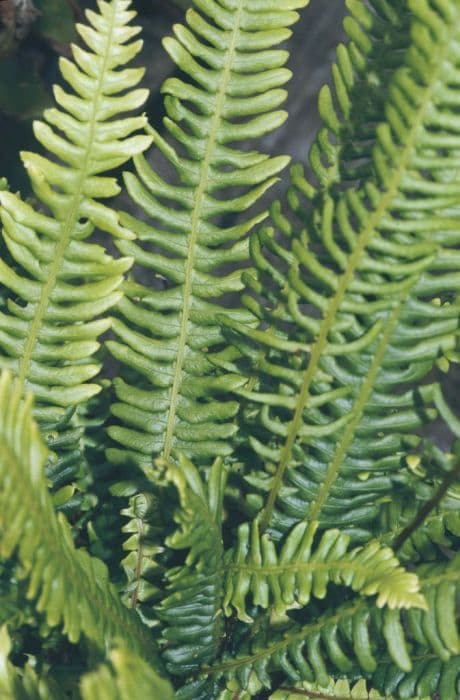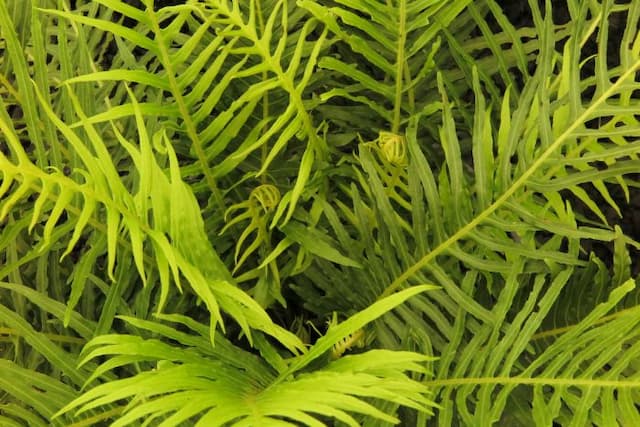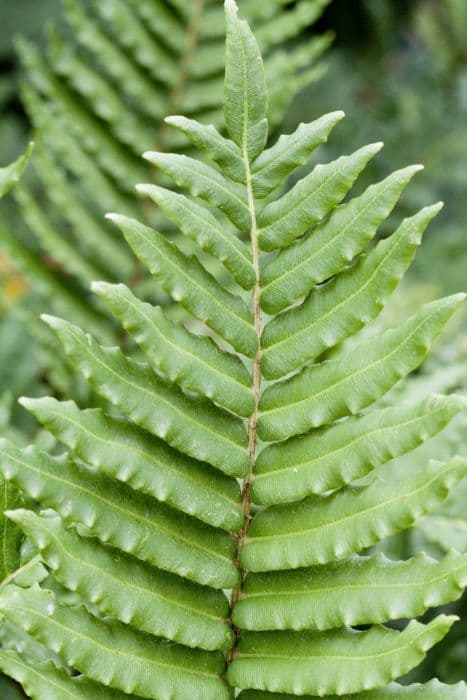Oriental Chain Fern Woodwardia orientalis var. formosana

ABOUT
The plant known commonly as the Oriental chain fern has a distinctive and attractive look that catches the eye. The leaves, also called fronds, are long and arching, creating a graceful and feathery effect. The color of the fronds can best be described as a vivid green, imbuing a sense of freshness to wherever they grow. These fronds are made up of numerous smaller leaflets that line the central stem, giving them a ladder-like appearance often described as "chain-like," which is a characteristic feature of this fern species. What's notably striking about the Oriental chain fern are the leaflets themselves. They have a slightly serrated or toothed edge and are arranged in an alternating pattern along the central stem. During certain times of the year, the underside of the leaflets will bear reproductive structures, which are typically covered in a different color, adding a subtle but interesting contrast to the green of the leaves. Interestingly, the texture of the fronds gives off a lush, almost tropical aura, contributing to the plant's overall ornamental quality. The fern has a natural elegance and can create a feeling of tranquility and greenery, making it a favorite among garden enthusiasts who wish to cultivate a serene and natural ambience in their outdoor spaces.
About this plant
 Names
NamesFamily
Blechnaceae
Synonyms
Oriental Chain Fern, Asian Chain Fern
Common names
Woodwardia formosana, Lorinseria formosana.
 Toxicity
ToxicityTo humans
There is no widely acknowledged or reported toxicity of the Oriental chain fern (Woodwardia orientalis) to humans. As with many plants, it is generally advisable not to ingest parts of plants that are not known to be edible, as they can cause stomach upset or other unintended effects. However, specific toxicity symptoms or consequences of consuming Oriental chain fern are not commonly documented in toxicology resources.
To pets
Similar to the information available for humans, there is no well-documented toxicity of the Oriental chain fern (Woodwardia orientalis) to pets such as cats and dogs. While the ingestion of non-edible plants can sometimes cause mild gastrointestinal upset in pets, there are no specific symptoms of poisoning or severe consequences linked to this particular fern that are widely recognized in veterinary sources. As a precaution, preventing pets from consuming any part of this plant is advisable to avoid potential, though unlikely, digestive issues.
 Characteristics
CharacteristicsLife cycle
Perennials
Foliage type
Evergreen
Color of leaves
Green
Height
2-3 feet (0.6-0.9 meters)
Spread
2-3 feet (0.6-0.9 meters)
Plant type
Fern
Hardiness zones
Varies
Native area
Asia
Benefits
 General Benefits
General Benefits- Ecosystem Support: Provides habitat and food for various insects and wildlife.
- Landscape Beautification: Adds aesthetic value to gardens with its lush green foliage.
- Erosion Control: Helps stabilize soil in landscaped areas, preventing erosion.
- Shade Provider: Offers shade in gardens and landscapes, creating a cooler microclimate.
- Low Maintenance: Requires relatively little care once established in suitable conditions.
- Cultural Significance: Holds importance in certain cultures for its beauty and use in landscaping.
- Education and Research: Serves as a subject for botany and horticulture studies due to its unique characteristics.
- Biodiversity Preservation: Contributes to the conservation of plant diversity.
 Medical Properties
Medical Properties- Anti-inflammatory: Woodwardia orientalis var. formosana has been traditionally used to reduce inflammation in certain traditional medicine practices.
- Antioxidant: Some research indicates that extracts from this plant may have antioxidant properties, helping to neutralize free radicals in the body.
 Air-purifying Qualities
Air-purifying QualitiesThis plant is not specifically known for air purifying qualities.
 Other Uses
Other Uses- Woodwardia orientalis var. formosana, commonly known as Oriental Chain Fern, can be used in landscape design for creating textured, natural-looking backgrounds or as a focal point in shade gardens due to its large and impressive fronds.
- It can be cultivated for use in terrariums or vivariums as it thrives in humid environments, providing a lush, green backdrop for other plants or small creatures.
- Oriental Chain Fern may be used in floral arrangements, particularly in ikebana, the Japanese art of flower arranging, for its elegant and long-lasting foliage.
- This fern species can function as a natural mulch due to its leaf litter, helping to maintain soil moisture and temperature while suppressing weeds.
- They are sometimes used in educational settings, such as school gardens or biology classes, to illustrate plant growth, reproduction through spores, and fern life cycles.
- The dried fronds of the Oriental Chain Fern can serve as artistic materials for creating nature-inspired crafts such as framed botanical art or textured papermaking.
- In eco-friendly construction, the fibrous roots of this fern have potential use as natural binding agents for soil erosion control or in the stabilization of slopes.
- The fern's ability to thrive in damp areas makes it a useful plant for restoring or creating wetland habitats, thus supporting local biodiversity.
- Gardeners may cultivate Oriental Chain Fern as a companion plant in vegetable gardens to create a microclimate that retains humidity, which can benefit certain crops.
- Its intricate frond patterns can inspire designs in various fields, such as textiles, architecture, or decorative arts, where natural forms are used as motifs.
Interesting Facts
 Feng Shui
Feng ShuiThe Taiwanese chain fern is not used in Feng Shui practice.
 Zodiac Sign Compitability
Zodiac Sign CompitabilityThe Taiwanese chain fern is not used in astrology practice.
 Plant Symbolism
Plant Symbolism- Resilience: Woodwardia orientalis var. formosana, commonly known as "Oriental Chain Fern," often grows in challenging environments, symbolizing the ability to thrive in difficult conditions.
- Growth: As a fern, this plant symbolizes new growth and expansion, reflecting its natural life cycle of unfurling fronds.
- Eternal Youth: Ferns, in general, are ancient plants that have survived through the ages, which often have them symbolize youthfulness and renewal.
 Water
WaterThe Oriental chain fern should be watered regularly to maintain evenly moist soil, especially during the growing season. Water the plant deeply once or twice a week, allowing for slight drying between waterings. Depending on the environment, this generally translates to about 1-2 gallons of water per week. Make sure not to overwater, as standing water can lead to root rot. Adjust the watering frequency during winter when the plant's water requirements decrease.
 Light
LightThe Oriental chain fern prefers bright, indirect light or partial shade. It thrives under the dappled light of larger trees or in an area that receives some morning sun followed by afternoon shade. Avoid exposing it to direct, harsh sunlight, as this can scorch the fronds and cause damage to the plant.
 Temperature
TemperatureOriental chain fern enjoys a warm and humid environment, thriving in temperatures between 65°F and 75°F. It can survive minimum temperatures down to about 50°F but should be protected from frost. Avoid exposing the fern to temperatures above 80°F as that can stress the plant.
 Pruning
PruningPruning is generally not essential for the Oriental chain fern, but you can remove dead or damaged fronds as needed to maintain the plant's appearance. The best time for pruning is in the spring as new growth begins. This helps the plant conserve energy and direct it towards the development of healthy new fronds.
 Cleaning
CleaningAs needed
 Soil
SoilThe best soil mix for the Oriental Chain Fern is one that is rich, moist, and well-draining, with a slightly acidic to neutral pH, ideally between 5.5 and 7. A mixture containing equal parts of peat, pine bark, and perlite would provide a suitable environment for healthy root growth. Regularly check the pH level and amend with sulfur or lime as necessary to maintain the ideal pH range.
 Repotting
RepottingOriental Chain Fern should be repotted every 2 to 3 years to refresh the soil and accommodate its growing root system. It is best to repot in the spring, just before the active growth season begins. If the plant is exceptionally large or you notice roots crowding the container, it may require more frequent repotting.
 Humidity & Misting
Humidity & MistingOriental Chain Fern thrives in high humidity conditions, ideally between 60% and 80%. To maintain optimum humidity levels, use a humidifier, mist the plant regularly, or set the pot on a pebble tray filled with water, ensuring that the pot does not sit directly in the water to avoid root rot.
 Suitable locations
Suitable locationsIndoor
Provide bright indirect light, keep soil moist, and ensure high humidity.
Outdoor
Grow in partial shade, moist soil, and protect from harsh sun.
Hardiness zone
8-10 USDA
 Life cycle
Life cycleWoodwardia orientalis var. formosana, also known as the Oriental Chain Fern, has a typical fern life cycle that begins with spore dispersion from the mature ferns' sporangia, typically located on the undersides of the fronds. These spores germinate into a gametophyte stage, commonly referred to as a prothallus, which is a small, heart-shaped, and photosynthetic tissue that grows on moist, shaded ground. The gametophyte supports sexual reproduction, producing both male (antheridia) and female (archegonia) sex organs. Upon fertilization, a zygote is formed and subsequently develops into a sporophyte, which is the recognizable leafy fern stage. The sporophyte grows through a juvenile phase where the fronds are smaller and less divided, eventually maturing to form larger and more complex fronds capable of undergoing photosynthesis, thus supporting the growth and development of the fern. Finally, once the sporophyte is mature, it produces new fronds that bear sporangia, completing the cycle as these release spores to begin the process anew.
 Propogation
PropogationPropogation time
Spring-Early Summer
Woodwardia orientalis var. formosana, commonly known as the Oriental Chain Fern, is a plant that can be propagated by spores. This method is the most popular when it comes to ferns due to the absence of seeds and flowers. To propagate by spores, the process should be carried out in a controlled environment to maintain humidity and temperature. Initially, spores are collected when the sporangia on the undersides of the fronds are ripe and then sown on the surface of a sterilized peat-based or peat-perlite mixture. This surface should remain damp, and the container must be covered with a clear lid or plastic wrap to maintain a high humidity level. The environment should have a consistent temperature of approximately 70 degrees Fahrenheit (21 degrees Celsius). After a period of growth, the tiny ferns can be transplanted into individual pots to continue their development.




